Myth III: The Wolf Age Updated Preview
Mumbo Jumbo drops by the GameSpot offices with a new build of Myth III.
See it in action!
Fortunately, as a part of Microsoft's purchase of Bungie, Take-Two Interactive acquired the rights to Myth, a real-time strategy series that removed the elements of resource management as well as structure and unit construction. Seven months after that announcement, Gathering of Developers unveiled Myth III: The Wolf Age, and announced Mumbo Jumbo--a relatively new studio made up of industry veterans whose previous work includes Fallout, Sin, and Heavy Metal F.A.K.K. 2--as the developer. It was also revealed that Myth III would be a prequel to the two previous Myth games, giving the development team an opportunity to explore and expand upon events that transpire 1000 years before the original Myth.
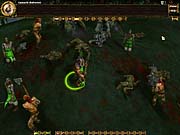
One of the benefits of creating a prequel in the Myth universe is that it shedslight on the background of certain characters that appeared in the original Myth and Myth II. "The world of Myth is basically divided into thousand-year cycles, and at the end of each [cycle], the hero of that age becomes the dark horse in the next age," said Mike Donges, executive producer at Mumbo Jumbo. "So, in our game, the heroes were the fallen lords of Myth and Myth II." Some of the characters making return appearances as heroes in Myth III are Balor, Soulblighter, and Shiver, all of which have different names to accommodate their new roles. These characters also serve as more than just a tool to advance the storyline or to make connections with previous Myth games, and in fact, you can actually play as the heroes at various points in the game. "In the first two games, most of your energy was focused on playing as foot soldiers," Donges said. "You still play as those characters, but we've also added the hero element so it should be interesting for people to play as characters that they had to fight against in the first games."
The affect that the heroes have on gameplay is immediately visible when confronting the hoards of enemies in Myth III. In one level, Connacht (who is known as Balor in the previous games), a few foot soldiers, and a warlock come across a river infested with ghols. After a few minutes of fighting between the foot soldiers and the ghols, the warlock moves to the top of a nearby hill and bombards the pack with a few fireballs, causing clouds of red mist and body parts to fly through the air and litter the surrounding area. A second wave of ghols moves up through the river to confront the foot soldiers, and at the same time, Connacht moves up to the front so he can engage the enemy, and not surprisingly, he almost single-handedly obliterates them. There are plenty of instances such as this where it's certainly tempting to throw a hero into the battle to eliminate enemies quickly, but if proper caution isn't taken, the situation can quickly turn sour and put the hero in serious danger.
New Units and Options
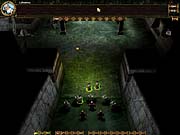
There are quite a few new units in Myth III: The Wolf Age, and most of them have been added to simply diversify the abilities of certain armies. One of these new units--and one that appears to be a personal favorite among the staff at Mumbo Jumbo--is the ghol shaman, a fairly unassuming unit that has spell-casting capabilities. "The ghol shaman has a spell called the savage wind dream," Donges explained. "Basically, the spell sucks everything into it, spins it around, and then blows it out." As expected, the resulting carnage is spectacular with limbs and other assorted body parts soaring through the air. Mumbo Jumbo hopes that the ghol shaman serves the dual purpose of being a useful offensive unit and a tool for teaching Myth novices that they need to be aware of their surroundings at all times. Donges added, "You really need to pay attention to the ghol shaman when it arrives on the scene."
The ghols aren't the only race to receive a boost in unit count as the dwarves also have some new faces among their ranks. Joining the dwarf demolitionists are the dwarf axe warriors, a group of dwarf axe warriors equipped with full armor and, of course, large weapons. The dwarf axe warriors are proficient in melee combat and are perfect for situations in which other units with long-range capabilities have been overwhelmed by enemy forces. Another new unit is the dwarf smith, which uses a flamethrower capable of doing widespread damage at a decent distance. Both of these new dwarf units are in the game for the express purpose of ensuring that the dwarves can initiate a balanced attack against any other army. The balancing act is especially evident in one of Myth III's multiplayer modes. "One of the things Myth III will allow you to do in multiplayer is to mount an army of a single race," said Donges. "You can pit a myrkridian army against a dwarf army and [the battle] will be fun and balanced."
Heroes bring a new element to Myth III as well. In addition to being generally strong units, heroes can give special bonuses to surrounding units. "All of the hero characters have a sphere of influence," Donges explained. "When your [regular units] are within a certain radius of the hero characters, those units fight more fiercely, have more accuracy, and can take more damage." But again, protecting your heroes is one of the most important tasks in Myth III, and if you blindly send one into battle to support regular units, there's always a slight chance that your hero could be ambushed and ultimately killed.
Selecting all of these units and placing them at strategic points on the map has been simplified. If you want to select a group of units, you can either drag-select, or you can double-click on a specific type of unit, and all units of that type in the area are automatically selected. Then by clicking on one of the numbers displayed on the top of the screen, you can assign a number to a group and call them up instantly by simply double-clicking the appropriate number. "Let's say you're off on one side of the map, and you want to get other units soon, you don't have to find them on the map," said Donges. "You can actually just double-click on their [group number], select them, and they'll move wherever you want them to move."
The Finer Details
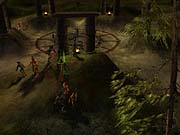
The basic differences between Myth III and previous games in the series are in the visuals. Instead of using a mixture of full three-dimensional terrain and soldiers made up of sprites, all objects are polygonal, giving the entire game a much more fluid and realistic look. While the visuals are completely redone for the prequel, the development team has used the Myth II engine for other aspects of the game. "We actually started off with the Myth II engine, but we gutted almost everything out of it except for the AI" Donges explained. "But the graphical engine is completely redone." The texturing system benefits tremendously from the engine overhaul as textures no longer look distorted when the camera zooms closer to the environments.
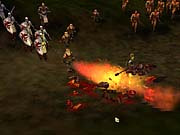
In addition, the lighting engine has been overhauled, so that it's much more dynamic. Dwarf bombs, or any other sources of light, emit a glow on surrounding areas, and there are even some cases where lighting becomes a key aspect of gameplay. "There are some interior levels where the only light that you have is the light you create yourself," Donges said. "From the marshland levels, you go into a series of caves, and you have a couple of villagers with you. If you accidentally let the villagers walk into the water, or if they get killed off, it'll put the lights out, making it really difficult to see."
Other environmental effects are much more apparent as well, such as wind. Zooming in on the ground reveals grass, bushes, and even trees gently swaying in the wind, and much like the lighting, the wind also affects gameplay. Whenever your army consists of archers or other units with long-range weapons, the wind directly influences the direction and range of those weapons. This knowledge is helpful in case there's a question of whether or not an opposing army is in range, or in case there is a chance that you could potentially do damage to your own units.
As it did in the previous games, water plays a crucial role in Myth III. During the single campaign or multiplayer battles, one of the more important strategies involves hiding your units in rivers or other bodies of water, increasing the possibility of launching a successful ambush on an opposing army. However, it's still possible to detect enemy forces hiding underneath water by maneuvering the camera in such a position that a portion of the water becomes transparent and reveals whatever is lurking in the depths. Likewise, units can hide within groups of bushes, but you can still detect them by watching how bushes move.
Most of the changes seen in Myth III are incredibly subtle or have very little impact on actual gameplay, and for obvious reason: Mumbo Jumbo hired a number of fans within the Myth community to help develop Myth III and ensure that it does nothing to drastically disrupt the Myth legacy. In fact, Mumbo Jumbo has used these same people as an initial quality assurance team. "The existing Myth community is still very rabid about the games," said Donges. "We want to make sure that we catered to them, so to do that, we actually hired some people from the Myth mod community. They're our Myth lore experts, so if we try to put in something new, they have the ability to [reject it]."
Final Thoughts
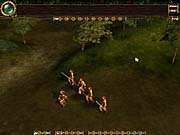
The single-player campaign in Myth III: The Wolf Age has 25 maps and attempts to fill in the gaps and expand upon parts of the Myth storyline introduced in the previous games. Much of the story seems to focus around the heroes, but the storyline eventually focuses on the dwarves and a journey to their home territory. Myth III features cutscenes, but they won't be quite like those found in the previous games. "We're still going to do animated cutscenes, but we're not going to have the cel-animated cutscenes from Myth I and Myth 2," Donges said. "We're going to tell the story through art, sketches, and prerendered cutscenes along with a narrator." Goals for the single-player campaign range from escorting and protecting villagers from enemy attack to more basic seek-and-destroy objectives. In one particular level, you have to travel through a series of underground structures as a group of dwarf axe men and smiths to find and destroy a level boss of sorts, all the while protecting your hero. For those concerned with the difficulty level of the game, there are three different difficulty settings, but Donges asserts that Myth III is still going to be a tough game, but not so difficult that a novice would have an incredibly hard time with the first few battles.
Myth III multiplayer will have a mix of old and new modes, including co-op, though some of the old modes have been scrapped because of their lack of popularity on Bungie's multiplayer service. One of the modes planned for the final game is called the grinder, in which your forces are placed on a map, and a constant flow of opposing forces are thrown at you. Whoever stays alive, wins the game.
Mumbo Jumbo currently has plans to ship the editing tools with the final release. The entire tool package, named Vengeance, lets you edit maps and units. During a demonstration of the editor, we were shown a map from the early parts in the game that was covered in a mesh. Each single square within the mesh can be manipulated to form different types of terrain (by clicking and dragging the mesh), objects can be dropped anywhere on the map, and you can decide where unit start points are located. It's actually quite impressive to see one of the final maps in the editor, and the amount of effort it takes to create a well-designed map. The character editor lets you view individual textures and edit their color scheme for team identification purposes. It's even possible to adjust the collision radius of individual units, change the parameters of the health bar and selection circle, and adjust the texture compression level.
From the looks of the build shown to us, Myth III: The Wolf Age looks like its well on its way to making a late October release. If there was anything missing in this game, it was quickly pointed out that they've already been incorporated in another build back at the Mumbo Jumbo offices. Either way, Myth fans have good reason to be excited for the latest game in the Myth series.
Got a news tip or want to contact us directly? Email news@gamespot.com
Join the conversation